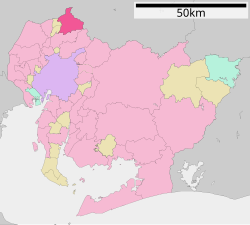Inuyama, Aichi
This article needs additional citations for verification. (November 2015) |
Inuyama
犬山市 | |
|---|---|
 Inuyama Castle, landmark place in Inuyama | |
 Location of Inuyama in Aichi Prefecture | |
| Coordinates: 35°22′43″N 136°56′40.2″E / 35.37861°N 136.944500°E | |
| Country | Japan |
| Region | Chūbu (Tōkai) |
| Prefecture | Aichi Prefecture |
| Government | |
| Area | |
• Total | 74.90 km2 (28.92 sq mi) |
| Population (May 1, 2012) | |
• Total | 74,200 |
| • Density | 991/km2 (2,570/sq mi) |
| Time zone | UTC+9 (Japan Standard Time) |
| - Tree | Chinese hawthorn |
| - Flower | Sakura |
| Phone number | 0568-61-1800 |
| Address | 36 Higashihata, Inuyama, Inuyama-shi, Aichi-ken 484-0081 |
| Website | Official website |

Inuyama (犬山市, Inuyama-shi) is a city in Aichi Prefecture, Japan, north of the Nagoya Metropolis.
As of May 2015[update], the city had an estimated population of 74,200 and a population density of 911 persons per km². The total area was 74.90 square kilometres (28.92 sq mi).[citation needed]
Geography
Inuyama lies along the edge of Aichi Prefecture, separated from neighboring Gifu Prefecture by the Kiso River.
Surrounding municipalities
Aichi Prefecture
Gifu Prefecture
History

During the Edo period, Inuyama was a sub-domain of Owari Domain, entrusted to senior retainers of the Nagoya-branch of the Tokugawa clan.
Immediately following the Meiji Restoration in 1868, it was established as an independent feudal han, until the 1871 abolition of the han system.
With the cadastral reforms of October 1, 1889, the town of Inuyama was created.
Inuyama was elevated to city status in 1954.
Transportation
Railway
- Meitetsu – Inuyama Line
- Meitetsu – Komaki Line
- Meitetsu – Hiromi Line
- Inuyama • * Tomioka-mae • Zenjino
Japan National Route
- Bridges
- Aigioohashi Bridge, crossing the Kiso River into Kakamigahara in Gifu Prefecture
Education
University
- National Universities
- Private Universities
Colleges
- Private Colleges
- Nagoya Keizai University Junior College
School
Inuyama has ten elementary schools, four middle schools, and two high schools.
Local attractions



Inuyama Castle
The most famous attraction is Inuyama Castle on a 40-meter rise overlooking the Kiso River. This Japanese castle was designated as a national treasure in 1935 and again in 1952. The castle in its current form was built in 1537 by Oda Nobuyasu, uncle of the great warlord Oda Nobunaga. It is the only privately owned castle in Japan and has remained unchanged since it was built — making it the oldest original wooden castle in Japan.

Other sights
The Kiso River has some very picturesque rapids upstream of Inuyama Castle. These rapids and the rock formations are called the Nihon Rhine after the Rhine river in Germany, and boat tours are available. Cormorant fishing on the Kiso River is nowadays almost exclusively done for tourists.
Near Inuyama is the Meiji Mura open-air architectural museum for preserving and exhibiting structures of the Meiji (1867–1912) and Taishō (1913–1926) eras. As of 2005, 67 historical buildings are preserved on an area of 1,000,000 m2. The most famous one is the main entrance and lobby of Tokyo's old Imperial Hotel, designed by Frank Lloyd Wright and built in 1923.
Another former open-air museum near Inuyama is also an amusement park called Little World Museum of Man. This anthropological museum contained a large number of buildings built according to the native style of over 22 countries.
Japan Monkey Park has different species of monkeys and other entertainment.
Inuyama is the site of the Primate Research Institute of Kyoto University,[1] one of the world's foremost centers for research in non-human primate biology and behavior. The chimpanzee Ai and her son Ayumu live there.
Culture
Urakuen
Another famous attraction is the Urakuen tea garden used for tea ceremonies. This garden contains the Jō-an tea house, built in 1618 by Oda Uraku (1547–1621), younger brother of Oda Nobunaga. Tea master Oda Uraku was a student of the famous tea master Sen no Rikyū. While the Jō-an tea house was originally built in Kyoto, it was moved to its current location in 1972. The building is considered one of the finest examples of tea house architecture.
Inuyama ware
Inuyama ware is a type of Japanese pottery made in the town in a number of kilns.
Sister cities
 - Tateyama, Toyama, Japan
- Tateyama, Toyama, Japan - Nichinan, Miyazaki, Japan
- Nichinan, Miyazaki, Japan – Davis, California, USA[2] since February 3, 2001
– Davis, California, USA[2] since February 3, 2001 - Xiangyang, Hubei, China[3] (friendship city since March 13, 1983)
- Xiangyang, Hubei, China[3] (friendship city since March 13, 1983) – Sankt Goarshausen, Germany [3] (friendship city since June 1, 1992)
– Sankt Goarshausen, Germany [3] (friendship city since June 1, 1992) - Haman County, South Gyeongsang Province, South Korea>,[3] since February 18, 2014
- Haman County, South Gyeongsang Province, South Korea>,[3] since February 18, 2014
Notable people from Inuyama
- Yashiro Rokurō – admiral in the Imperial Japanese Navy
- Kaori Moritani – musician
References
- ^ Monkeys use trees as catapults in escape from Kyoto Uni's primate research centre, 7 July 2010 , The Courier-Mail, Queensland Newspapers.
- ^ "US-Japan Sister Cities by State". Asia Matters for America. Honolulu, HI: East-West Center. Retrieved 20 November 2015.
- ^ a b c "International Exchange". List of Affiliation Partners within Prefectures. Council of Local Authorities for International Relations (CLAIR). Archived from the original on 24 December 2015. Retrieved 21 November 2015.
{{cite web}}: Unknown parameter|deadurl=ignored (|url-status=suggested) (help)
External links
 Inuyama travel guide from Wikivoyage
Inuyama travel guide from Wikivoyage- Official website
- Inuyama City Tourist Association website




